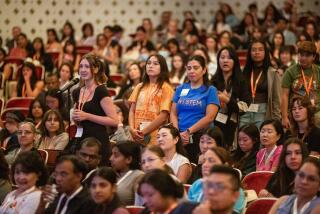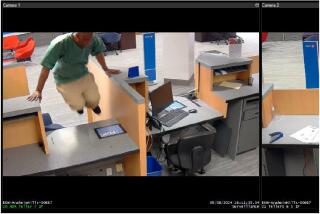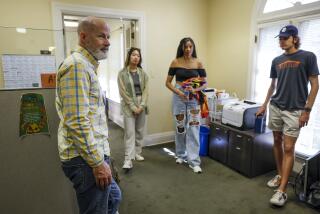Harry the Horse : Whether blazing organic trails or binging on pizza, honored Caltech professor keeps the chemistry alive
- Share via
Another year will begin Monday at Caltech, where, in keeping with rich tradition, students will pull off some outrageous prank, the faculty will acquire more international prestige and Harry (the Horse) Gray will convulse Chem I.
That’s how it has been during the 22 years that the eminent chemist Gray has been whipping up his unique brew of creativity and clowning.
For the record:
12:00 a.m. Sept. 29, 1988 For the Record
Los Angeles Times Thursday September 29, 1988 Home Edition San Gabriel Valley Part 9 Page 2 Column 4 Zones Desk 1 inches; 20 words Type of Material: Correction
Caltech scientist Harry Gray’s specialty was incorrectly identified in an article (Times, Sept. 25). Gray is a pioneer in inorganic chemistry.
As Gray likes to say, “You gotta keep people excited.”
To many, the 52-year-old Gray personifies Caltech, where imaginative antics are respected as a mark of scientific genius.
Among students, Gray seems to take on mythic proportions as the professor who lectured in a horse’s costume one Halloween. That was when he was still working toward a discovery in 1982 that led to winning the nation’s top scientific award, the National Medal of Science, in 1986.
Known thereafter as “Harry the Horse,” Gray was the first professor to appear in a Caltech student production. The director was inspired to cast him as the crapshooter Harry the Horse in “Guys and Dolls” because of Gray’s nickname.
Gray is among the most prestigious, award-winning scientists at Caltech, which has 21 Nobel laureates among its faculty and alumni.
Gray was named California Scientist of the Year last spring by the California Museum Foundation of the California Museum of Science and Industry, and will head the Beckman Institute at Caltech when it opens late next year. The interdisciplinary institute will be unique to Caltech, focusing on chemistry-biology and chemistry-engineering projects for scientists all over the world. Gray said he will do some research there.
But even while heading the center, Gray said he will teach freshman chemistry, something many top professors eschew in favor of working with graduate students. All students at the school must take Chemistry I, and classes usually average about 200 students.
Teaching Chem I is important, Gray said, “because I think teaching young people who are just learning things for the first time is what keeps us all going.”
Yet musing over his upbringing in rural Kentucky, where chemistry and higher education were virtually unknown, Gray pondered the irony that he had never had an inspirational teacher when he was the age his students are now. Ignited by his own curiosity and “a family of eccentrics,” he wonders whether “all the fancy education it takes to get to a place like this” might snuff out the kind of creative sparks that fired him as a child.
“You can do plenty of things without teachers,” he said.
In bursts of ebullience, partly to keep the sparks flying and partly because he can’t help it, Gray jokes, conducts dramatic chemical demonstrations, roars with laughter and clowns with 18-year-olds, wondering what they’ll think of next.
They trashed his office, so he wore the horse costume. They reversed all the seats in his lecture hall, so he taught from a tiny chalkboard in the back. They brought in a Hare Krishna monk to chant all day, began a class with a popular song about scientific elements and once rewired his office.
Gray and a team of graduate students binged on pizza on the day in 1982 when they had proof that proteins transfer electrons over longer distances in living cells than scientists had previously believed. They recorded the great moment in scientific history on the empty pizza containers.
A spokesman at the California Museum of Science and Industry said Grey’s “findings affect scientific issues as diverse as meeting future energy needs and computer miniaturization.”
Key Role
Electron transfer plays a key role in photosynthesis, the biological process that provides most of the world’s energy supply and oxygen. Gray’s discovery provides greater understanding of how photosynthesis works in transforming carbon dioxide into oxygen. It opens possibilities for developing an artificial counterpart to photosynthesis. Museum spokesmen said that through Gray’s work, researchers are learning how energy storage and conversion can be achieved in synthetic chemical systems.
A Caltech spokesman said new synthetic chemical systems may be adapted to the role that silicon chips now play in computers.
Gray said solving such problems as energy shortages and the increase in carbon dioxide that is believed to cause the so-called greenhouse effect in the Earth’s atmosphere are “possibilities at the end of a long rainbow, but at least we are beginning to understand how Mother Nature solved the same problems.”
When Gray returned from the White House, where he received the National Medal of Science for his pioneering work, students met him at the airport and “kidnaped” him for a late night beach party.
“I like pranks better than anybody,” Gray said. But he has never participated in students’ infamous “high-tech” kinds of stunts, such as converting the hillside HOLLYWOOD sign to say CALTECH last year.
‘Instant Gratification’
“I think those are wonderful, but they are two-year projects,” he said. “Mine have been more for instant gratification.”
Last year Gray told awful jokes, led Christmas singing, reportedly approved beer-brewing for one chemistry group project and applauded freshmen like Sam Dinkin for their classroom repartee, according to Dinkin.
“He is one of the great chem teachers in the world,” said Dinkin, one of Gray’s freshmen students last year.
Former student Mark Wrighton, who now chairs the Chemistry Department at Massachusetts Institute of Technology, said: “You could view your mentor as an albatross but with Harry, people regard it as an honor to have him. To a lot of people he epitomizes what Caltech is all about, in the sense of outstanding science in a setting of informality.”
Michael Albin, a former Caltech postdoctoral student who works in inorganic chemistry in a pharmaceutical company in Palo Alto, called Gray “one of the top scientists in chemistry.”
“He has made key contributions and has attracted a lot of good students,” Albin said. “There’s an exchange of extraordinary loyalty there.”
Gray dates his clowning to early childhood, when he was the proverbial kid in the basement threatening to blow up the house with his chemistry set. He tells of the day he emptied the entire high school in Bowling Green (where his father was principal) with a smoke bomb.
“I come from this totally eccentric family where there may have been a lot of undeveloped scientific talent,” Gray said.
“From the first time I mixed a couple of chemicals together, it was so fascinating to me. I never wavered.
Mystery of Colors
“In high school I knew far more than anyone else because I learned it all myself, but I was puzzled by so much--why things change colors, formulas that I didn’t understand,” Gray said.
“I was dying to know these explanations, so when I finally got some real chemistry teaching, there was this tremendous exhilaration. I was so hungry to learn that it was just like an explosion. It was unbelievable!”
“A lot of people are burned out” by the time they reach college, Gray said, and he questions education that “overteaches” by pumping knowledge into young students instead of allowing them to hunger for it, as he did.
“There’s no time for them to sit back and wonder--what does all this mean?” Gray said. “The system is so structured and difficult now that I think a lot of creative people are getting shoved aside. They could be going into science but they get cut off before they get there. We’re missing a lot of potentially creative kids. I’d like to tell them somehow that they can and should keep going because science is tremendously exciting.”
‘Get Out of Kentucky’
Fired as much by “a tremendous desire to get out of Kentucky” as curiosity, Gray said, he studied at Northwestern University near Chicago and the University of Copenhagen, taught at Columbia University in New York and came to Caltech in 1966 as a full professor at the age of 30.
“My field of organic chemistry was taking off at the right time, just exploding around me, and I was on the ground floor. That was a lucky break,” he said.
His wife, Shirley, calls Gray “a contradiction--a flamboyant personality who’s really a very careful scientist.”
She is a former math teacher at South Pasadena High School, Pasadena City College and Cal State Northridge and is working toward a doctorate in math education at USC.
Their children are Vicki, 29, who has two master’s degrees from Stanford and works in biotechnology in a Honolulu hospital; Andy, 27, a physician at UC San Diego, and Mike, 15, a basketball star at Blair High School in Pasadena.
‘Extrovert Personality’
“If you didn’t know Harry well he might seem a very superficial politician, with such an extrovert personality,” Shirley Gray said. “But in fact, as a scientist he is more careful than most. He’s secure enough now that he doesn’t mind telling students to go back and do (an experiment) again five, six, seven times.”
Gray said that the fact that electrons can move farther than scientists believed before his discovery has vast implications. He said he receives a theoretical paper from someone from some part of the world almost every week and that thousands of studies have stemmed from the pioneering work. On one recent day visiting scholars from Italy and Holland were among the steady stream of scientists who sought him out.
“The only thing wrong with Harry is that everybody wants him, so he gets kind of inaccessible even though he doesn’t want to,” one student complained.
‘Benchmark Contributions’
Several scientists said Gray has done pioneering work in other fields, including platinum chemistry, photochemistry of inorganic materials and in the field of oxidation and reduction.
“He’s made what chemists call benchmark contributions in all these,” Wrighton of MIT said.
“He’s one of the most famous in the world,” said John Brewer, last year’s teaching assistant in Chemistry I who had heard of Gray from some of the 15 books and more than 400 scientific articles he has written.
“Chemistry to many people is a job, but to Harry it’s a series of fun discoveries,” said Nate Lewis, who once froze Gray’s office with liquid nitrogen “because it was too warm.”
“He’s the reason I’m in chemistry,” said Lewis, who recently returned to Caltech as an associate professor after teaching at MIT and Stanford. “He always is positive. I can still hear him saying, ‘If you can’t do that, no one can--just keep it up.’ ”
Although Gray’s conversation is studded with “exciting,” “totally outrageous,” “fantastic,” “tremendous” and “explosive,” he can switch easily to contemplation.
“I paid my dues to get here,” he said.
Repetitious Work
He sat through tedious courses, did repetitious work and likens successful scientists to great musicians--”behind the showmanship there’s gotta be strong technical background that you can only get by tremendous organization and desire and hard work,” he said.
“We’re all performers, and we want to keep people excited, but life is not just this. You really have to work your tail off and learn lots of stuff, and some of it is extremely boring. There are no shortcuts.”
“The only wonderful thing a teacher can do is get you excited and interested enough that you’re willing to put in really long hard work day after day after day to get you to the technical level that’s needed.
“And then you get these fantastically great, exciting, tremendous experiences. And you get to be outrageous.”
More to Read
Sign up for Essential California
The most important California stories and recommendations in your inbox every morning.
You may occasionally receive promotional content from the Los Angeles Times.










